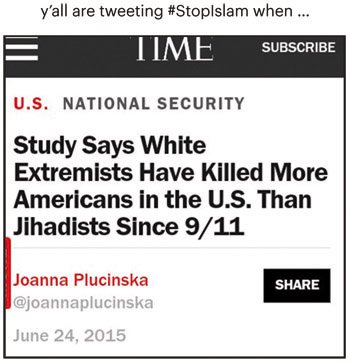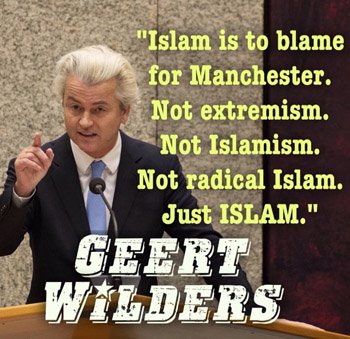Contesting #stopIslam: Tensions around hate speech on social media
by Elizabeth Poole and Ed de Quincey & Eva Giraud
- Date
- 22 Jun 2018
Published in British Academy Review, No. 33 (Summer 2018).
The print version of this article can be downloaded as a PDF file.
Dr Elizabeth Poole is Senior Lecturer, and Dr Eva Giraud is Lecturer, in the Department of Media, Communications and Culture at Keele University. Dr Ed de Quincey is Senior Lecturer in Computing at Keele University.
 |  |  |
Twitter hashtags are used to categorise Tweets: they allow people to search for topics more easily. But they also communicate agendas and mobilise people into like-minded communities, so have become a popular form of politically mediated communication. In this article we show how groups with different politics negotiate the tensions between them through the interactions afforded by Twitter, and we examine the possibilities of challenging hate speech online.
The hashtag #stopIslam appears to be both racially motivated and critical of Islam. It has been used previously, particularly following terror attacks, to vilify Islam and Muslims. However, after the Brussels terror attack, on 22 March 2016, it came to our attention because of the large number of tweets using it to defend Islam. This response was also noticed by the mainstream media (CNN, Daily Express, Daily Mirror, Washington Post) who reported on the hashtag trending. These media organisations tended to focus on the ‘counter-narratives’ about Islam reflected in the ‘twittersphere’, which often attempted to negate the relationship between Islam and terrorism. The prominence of these critical responses to #stopIslam, both on Twitter itself and within the mainstream media, raised questions for us about when and why counter-discourses about Islam and Muslims can gain a presence in the public sphere. We developed a project ‘Who speaks for Muslims?’, funded by a British Academy Small Research Grant, to explore how these Islamophobic messages played out online. Originally formulated to ask questions about self-representation and voice on social media, the issues it raises speak to growing concerns about the rise of right-wing populism, a surge in reports of hate speech, and the use of social media by white supremacist groups.
Media representations of Muslims
It is well-documented in academic research that the media, particularly the UK’s print media, tends towards a negative representation of Muslims. Coverage is dominated by: associations with terrorism, conflict, extremism and violence; a focus on inherent cultural differences; and an overemphasis on religious belief as a causal factor.
It is often suggested that social media offers a space to counter these negative representations, especially given the opportunities for self-representation on this platform. Twitter hashtags such as #notinmyname, which has been used by British Muslims to condemn the activities of ISIS, do get an airing in mainstream media. But positive actions like these are largely drowned out by the sea of negative coverage about Muslims.
The trajectory of the hashtag #stopIslam adds another dimension to the argument. The hashtag seemed to be hi-jacked by activists seeking to counter those dominant negative discourses about Islam which were circulating both in mainstream media and more vociferously through the #stopIslam hashtag itself. So, looking at the dynamics of counter-narratives against #stopIslam offered us the opportunity to explore whether social media presents genuine opportunities for self-representation, or if the counter-narrative is instead dominated by would-be allies, Twitter celebrities and institutions.
Anti-Muslim propaganda on Twitter and the role for the far-right
#stopIslam has been circulated following several recent terror attacks in Europe, from the Paris attack of 2015 to London in 2017. Given this context, we expected to find a preponderance of European far-right voices in the debate. But we were wrong.
Our research instead shows some of the ways that the far-right in the US are using Twitter as a platform for anti-Muslim propaganda. It also revealed how, in the run up to the Presidential election, pro-Trump supporters engaged with Twitter in an attempt to boost the profile and political success of Trump and his political allies.
The hashtag, which peaked on the day of the Brussels attacks, 22 March 2016, 4-7pm, began as an attack on Islam, as one would expect given its name. It was frequently retweeted with similar hashtags such as #islamistheproblem, #bansharia, and #islamkills. However, and more worringly, these messages were tweeted in relation to US-based right-wing conservative groups on Twitter – such as the Tea Party, CCOT (Conservatives on Twitter), TCOT (Top Conservatives on Twitter) – and in conjunction with hashtags such as #Trump2016 and #wakeupamerica. This anti-Islamic hashtag was combined with anti-Democrat rhetoric in an attempt to bolster Donald Trump’s campaign in the Presidential race. Further network analysis demonstrated the inter-connections between these far-right groups, who were actively circulating memes to each other and with some anti-Muslim groups in Europe, such as Geert Wilders and his PVV (Party for Freedom).

The self-penned biographies of tweeters further revealed their politics, featuring the phrases and imagery of the alt-right: pro-life, pro-guns, pro-Israel, anti-feminism, combined with patriotic and Christian symbols. Many of the tweets included memes and links to far-right websites, which were targeted at anyone defending Islam as part of a strategy to undermine critics of the right using ‘evidence’ as opposed to ‘fake news’.
Counter-discourse: defending Islam
You might ask, what else would you expect from a negative hashtag such as #stopIslam? However, our analysis of the most retweeted tweets (i.e. those that were shared most widely by others) demonstrated a different trend: that the majority of these tweets were actually using the hashtag to counter anti-Muslim hatred. For example, many of the tweets refuted the relationship between Islam and terrorism, and argued that Islam was a religion of peace. There was also a series of memes designed to contest Islamophobic narratives, which began with the phrase ‘y'all are tweeting #StopIslam when’, and were then followed by a variety of memes about white supremacism. The illustrated tweet was retweeted 6,643 times, compared to the 1,500 times the top anti-Muslim tweet was shared (and that was the only anti-Muslim tweet in the ten most retweeted tweets). Other positive Tweets asked: ‘Why is #StopIslam trending? It should be #StopISIS’ (shared 3,791 times), and ‘#StopIslam? Eh, the muslim boys next door bring me tomyam [hot soup] whenever I'm sick. Why would I stop kind souls like them?’ (shared 2,500 times).

These messages of solidarity were so prominent initially that they were picked up on by many mainstream news organisations (CNN, Independent, and Washington Post, for example), which by doing so also shared the counter-narrative itself, defending Muslims from this online attack. The visibility of this counter-narrative echoes the claims of a number of academics that particular uses of Twitter can enable grassroots collectives to change a story that seeks to spread hatred into something much more positive. The success of the counter-narrative seemed to suggest that, because of the particular characteristics of Twitter, people do often stray out of their ‘echo chambers’ to interact and challenge views they dispute, and the use of hashtags and re-tweeting provides this functionality.
Reverting back to racism
However, the positive voices we identified seem to be quite dispersed (both socially and geographically), as well as short-lived. In our closer qualitative analysis of debates that surrounded individual tweets, we found that far-right activists frequently trolled the accounts of those sharing more positive messages, and responded to counter-narratives with a deluge of anti-Islamic memes. The findings indicate that the strength of this far-right discourse is due to their tightly bound groups that persistently and aggressively attack and bury any counter-narratives that emerge online. While Muslim voices were present in the counter-narrative, tweeters defending Islam were less networked, and most Muslims appeared as commenters, agreeing with favourable tweets before being silenced by the intimidating discourse of the right. As well as being circulated by supportive non-Muslims activists, the counter-discourse was often spread by celebrities and media institutions who were less likely to engage any further in ongoing debates.
Another issue facing counter-narratives against hate speech is that of longevity. The ‘fightback’ lasted only 24 hours after the attack, while the anti-Islamic discourses continued – albeit on a lesser scale. A more recent survey of the hashtag showed how it has reverted back to being wholly negative towards Muslims. Ongoing uses of the hashtag were linked to terrorist attacks in Manchester and London, whilst continuing to be US-based, and combined patriotic imagery and anti-Muslims memes.

The success of these hashtag campaigns, elevating both Trump and far-right groups beyond their core constituencies, showed how integral this identity politics is in contemporary populist movements. Anti-immigration rhetoric has been key to the success of the right across the US and Europe in recent elections, and this research shows how social media is being used aggressively to this effect, undermining any solidarities that arise in response. Since the UK’s EU referendum and the US Presidential election, this discourse has increasingly gained prominence in the mainstream: for example, the recent re-tweeting by Trump of anti-Muslim videos by Britain First went one step further in legitimising the racism of a far-right group.
Our ‘Who speaks for Muslims?’ project provides further evidence for arguments suggesting that social media can no longer be dismissed as trivial and insignificant in politically mediated communications. From an analysis of the tensions between racist and anti-racist activists on Twitter, it is evident that racist discourse can be appropriated, and in these moments ‘counter-publics’ do form and are able to make their presence felt in the public sphere. However, this appears to be fleeting and short-lived. Although, in the context of this campaign, it seems that progressive politics has something to learn from the right in using these platforms effectively, it is possible that anti-racist activists feel there is nothing to gain by engaging in contentious exchanges with the far-right. In fact, this could well be an active choice to prevent the further circulation of this racist hashtag. However, this project shows how engaging with social media platforms can contribute to the wider dissemination of anti-racist discourse, and is therefore an important strategy for gaining ground in the context of ‘information warfare’ that we now find ourselves in.
How are we doing? Your feedback is important to help us shape future issues of the British Academy Review.
To provide reader feedback, please visit www.britishacademy.ac.uk/british-academy-review-feedback